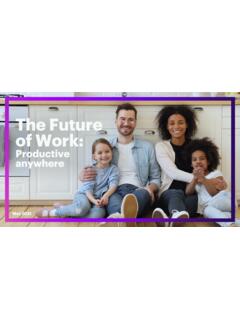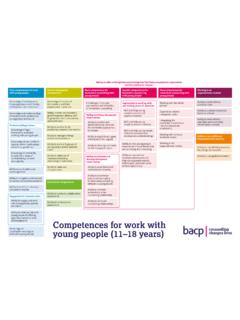Transcription of Teenagers’ Career Aspirations and the Future of Work
1 Teenagers Career Aspirations and the Future of WorkBy Anthony Mann, Vanessa Denis, Andreas Schleicher, Hamoon Ekhtiari, Terralynn Forsyth, Elvin Liu, and Nick Chambers2 OECDThis publication was produced by Anthony Mann, Vanessa Denis and Andreas Schleicher (all OECD) with Hamoon Ekhtiari, Terralynn Forsyth, Elvin Liu (all FutureFit AI) and Nick Chambers (Education and Employers). The publication design was overseen by Sophie Limoges (OECD).The OECD gratefully acknowledges the support of our partners in this work , the Jacobs Foundation (Switzerland), the National Center on Education and the Economy (United States), FutureFit AI (Canada) and the Education and Employers charity (United Kingdom).
2 FutureFit AI led the analysis with regard to the sections on labour market relevance and job this publicationOECD3 Across the world, the young people who leave education today are, on average, more highly qualified than any preceding generation in history. They often enter the working world with considerably more years of schooling than their parents or grandparents. This is an enormous achievement of which the global education community can be truly proud. And yet, in spite of completing an unprecedented number of years of formal education, young people continue to struggle in the job market, and governments continue to worry about the mismatch between what societies and economies demand and education systems supply.
3 The co-existence of unemployed university graduates and employers who say they cannot find people with the skills they need, shows that more education does not automatically mean better jobs and better lives. For many young people, academic success alone has proved an insufficient means of ensuring a smooth transition into good employment. I firmly believe that education is the fundamental driving force for social progress. With the world of work changing so quickly, there is strong reason to believe that schools need to look afresh at how they can better prepare young people for their lives.
4 The industrial age taught us how to educate second-class robots, people who learn in standardised settings and become good at repeating what we tell them. In this age of accelerations, we need to think harder about what makes us first-class humans, how we complement, not substitute, the artificial intelligence we have created in our computers, and how we build a culture that facilitates learning, unlearning and re-learning throughout new generation of citizens requires not just strong academic skills, but also curiosity, imagination, empathy, entrepreneurship and resilience.
5 They need confidence and determination to create their own employment and to manage their careers in new ways. Effective education systems will go beyond traditional teaching techniques. Not only will they provide learners with knowledge relevant to Future employment, they will also develop the ability of learners to be personally effective in applying that knowledge in changing situations. Staying longer in education than ever before, today s young people must make more decisions about what, where and how hard they will study. These are investment decisions that are becoming increasingly difficult because technology is changing the working world itself so quickly.
6 Good schools will respond by helping young people to become critical thinkers about the labour market and how it relates to their learning. Never before has effective Career guidance been so important and never before has there been a greater onus on employers to step up and work with schools to help young people understand jobs and careers and help teachers bring learning to spectre of the unemployed graduate speaks to a divide between the worlds of education and employment. This publication draws on the best data in the world to understand the extent of the challenge and what is to be gained by closing the gap.
7 Seeking insights from over half a million 15-year-olds in the 79 countries that took part in the latest PISA assessment, unprecedented analysis is presented on contemporary teenage Career expectations, how they are formed, and how they are related to gender, geography and the Future of work . Assuredly, schooling is not simply about preparing for work , but we owe it to our young people to ensure that they go through education blind neither to the opportunities offered by the working world nor to its potential pitfalls. As this multi-year project develops, data from so many countries will present schools and governments with important scope for peer learning.
8 We owe it to our young people to ensure that these are opportunities that are fully Yidan Co-Founder of Tencent4 OECDOECD5 Career confusion in the 21st century: Challenges and opportunitiesEvery day, teenagers make important decisions that are relevant to their Future . The time and energy they dedicate to learning and the fields of study where they place their greatest efforts profoundly shape the opportunities they will have throughout their lives. A key source of motivation for students to study hard is to realise their dreams for work and life. Those dreams and Aspirations , in turn, do not just depend on students talents, but they can be hugely influenced by the personal background of students and their families as well as by the depth and breadth of their knowledge about the world of work .
9 In a nutshell, students cannot be what they cannot young people staying in education longer than ever and the labour market automating with unprecedented speed, students need help to make sense of the world of work . In 2018, the OECD Programme for International Student Assessment (PISA), the world s largest dataset on young people s educational experiences, collected first-of-its kind data on this, making it possible to explore how much the Career dreams of young people have changed over the past 20 years, how closely they are related to actual labour demand, and how closely Aspirations are shaped by social background and gender.
10 Studies in Australia, the United Kingdom and the United States, which follow groups of young people from childhood to adulthood, show that teenagers who combine part-time employment with full-time education do better than would be expected in their school-to- work transitions. They highlight a range of positive benefits, including lower likelihoods of being unemployed or NEET (Not in Education, Employment or Training), higher wages, greater chances of pursuing apprenticeships and greater contentment in their Career progression (Box ). Engagement with the working world can lead to positive educational, economic and social outcomes for young people, but benefits cannot be taken for granted.

















